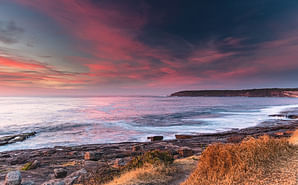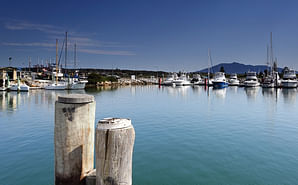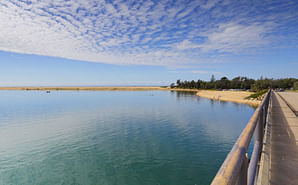Ocean Outfall
Some frequently asked questions and answers.

Questions and Answer
A: AECOM developed the Merimbula Effluent Management Options Study between 2009-2013. This study investigated strategic alternatives to the project including new and expanded re-use schemes as well as STP upgrade and disposal options. All schemes included the need for a disposal option.
Council currently partners with community groups, farmers and golf clubs to operate ten recycled water irrigation schemes between Bermagui in the north and Eden in the south. About a quarter of our community’s treated sewage is recycled and used beneficially in an average rainfall year. Council is looking to expand this scheme through developing a Recycled Water Strategy.
No scheme escapes the need for a back-up disposal option. In wetter times, demand for re-use drops and inflow to the STP spikes.
In addition to this, we currently reuse 100% of biosolids from our sewage treatment plants. This valuable resource is made available to local farmers who use it to improve soil health.
A: Currently, we pump treated effluent onto the beach, midway between Merimbula and Pambula. This is a blight on an otherwise visually stunning beach. It also poses the greatest risk for contamination as dilution and dispersal so close to the shore is minimal.
Our planned sewage treatment plant upgrade will take an improved quality effluent 2.7km out to sea where offshore currents will diffuse and dilute the effluent more than onshore processes can achieve.
In recognition of this, the NSW EPA has instructed us to upgrade the Merimbula Sewage Treatment Plant and construct a new ocean outfall pipe.
In the daytime and during summer, when we can’t use the existing outfall, treated wastewater is pumped into dunal exfiltration ponds behind Merimbula Beach.
Their ongoing use is unacceptable as they are constructed on culturally sensitive land of great significance to the local Aboriginal community and on endangered bangalay sand forest environments.
An ocean outfall pipe will remove the need for exfiltration ponds, which will be handed back to the local Aboriginal community.
A: While we are in a good position currently, with clean bay waters supporting healthy seafood and recreational businesses, we recognise there are ways to achieve better results through looking at cultural and environmental sensitivities, and planning for the future as the local population increases.
In 2009, the NSW EPA required Council to start investigating better disposal options. After investigating a wide range of options, Council assessed the options with a community focus group made up of state government, interest groups and local community members.
In 2013, the group and Council agreed a deep ocean outfall is the preferred option to cater for cultural and environmental needs, as well as increased pressure from population growth. Compared to other options the deep ocean outfall has:
-
the greatest environmental benefit through improving water quality and ecology
-
least construction and operational impacts recognising the value the Merimbula community places on its beach and ocean fronts
-
the least impact on culturally and environmentally sensitive areas
-
is more socially, environmentally and economically sustainable in the long term.
As a result, the EPA amended Council's operating licence for the Merimbula STP to include a requirement to construct an ocean outfall pipe, with upgrades to the STP.
A: Algal blooms are a naturally occurring phenomenon. The algae most experienced locally is Hincksia sordida, a resident of Merimbula Bay that often moves closer to shorelines due to the summer easterly and north-easterly winds. A 2013 independent study of algal blooms in Merimbula Bay found that nutrient content from treated effluent was only one of many food sources this type of algae utilised for growth. The study also found numerous accounts from long-term Merimbula residents indicating the presence of regular algal blooms as far back as the 1950s, more than 20 years before the commissioning of the Merimbula Sewage Treatment Plant.
- Yes, the EIS will establish an ongoing program of monitoring of any potentially impacted environment.
- The following assessments have already been carried out:
- In conjunction with Council, consultants from AECOM have been monitoring the STP and Merimbula Bay to inform the decision making about the STP upgrade and the best alignment for the ocean outfall.
- Studies have focused on the water in the bay and the ground below it, including above and below the seabed. Looking below the seabed allows us to understand construction challenges while looking above the seabed allows us to map formations like rocky reefs.
- We have carried out marine ecology studies, which have focused on the plants and animals in Merimbula Bay, the coastal waters to the north and south of the Bay, as well as Merimbula Lake and Pambula Lake.
- In November 2018, we carried out geotechnical investigations around the exfiltration ponds at the Sewage Treatment Plant. The results will be correlated with available historical information to help us understand ground conditions to inform infrastructure design.
- In October 2018, we completed heritage investigations at the STP to search the area for heritage items, including items of Aboriginal significance.
- We have done multiple dye dispersion tests in Merimbula Bay to understand how waterborne materials travel and spread in the bay’s currents. We did our first test in August 2017 and one in May 2018. By testing at different times of year and at different depths and locations, we can get a complete picture of how currents behave in different water temperatures and depths. This information has informed the preferred location for the ocean outfall.
- In September 2017, we did a flora and fauna study. Over several days, we looked for different plants and animals in the area between the STP and Merimbula Bay using direct observations (seeing a species or hearing a call) and indirect observations (seeing habitats, hair or tracks).
The beach-face outfall has been discharging treated wastewater at the centre of Merimbula Beach since 1974. The treated wastewater flows across the beach and into the ocean waters of Merimbula Bay.
- The original ocean outfall was commissioned in 1972 following the sewering of Merimbula, Pambula Beach and Pambula and construction of the Merimbula STP. It extended into the ocean and beyond the surf zone. In 1974 it was damaged by large seas and a temporary beach-face outfall was constructed. This temporary outfall remains in the same location to this day.
- Council has discussed the impact of the ocean outfall pipe on the artificial reef with NSW DPI Fisheries. Potential Impact on the artificial reef along with the other natural reefs in Merimbula Bay have been considered as part of the Environmental assessment. The assessment concludes there is minimal risk of impact to these reefs from the operation of the proposed outfall.
- Stormwater can reach the sewer system through groundwater infiltration or accidental inflow if gutters are connected incorrectly. This has a big effect on the volume of sewage that the STP has to treat and dispose of. In a big storm the STP can receive an entire weeks’ worth of sewage in one day.
- After prolonged rainfall, the beneficial reuse sites do not have the capacity or storage to take extra treated wastewater. The excess needs to go somewhere. Currently, it is sent to a beach-face outfall pipe on Merimbula Beach (or to exfiltration ponds in the nearby sand dunes), which is not acceptable or sustainable.
- All large sewerage schemes need a way to deal with the volume of treated wastewater unable to be reused.
- Coastal sewage treatment plants with ocean outfalls are very common. There are 30 active ocean outfalls along the NSW coast.
- The transfer pipeline from the STP will run mainly underground to a submerged diffuser located on the seabed. The preferred alignment has the diffuser located approximately 3.5km from the STP (2.7 km offshore).
- The diffuser releases treated wastewater in fine jets and makes sure that the treated wastewater is effectively mixed and diluted with ocean water.
- The preferred alignment would see the pipeline constructed between 10-20m beneath the sand dunes, via a trenchless drilling method Specialist contractors would be engaged to complete the detailed design and trenchless drilling works.
- The preferred diffuser location is approximately 30m deep.
- The preferred alignment would see the diffuser positioned 3.5km from the STP, centrally in Merimbula bay.
- Yes, the Environmental Impact Statement (EIS) will establish an ongoing program of monitoring of any potentially impacted environment.
- Read more about the Environmental Assessments that have been undertaken so far.
- Ocean outfalls pose fewer risks compared with river outfalls because river ecology is more sensitive and the conditions for mixing, dilution and dispersion are more limited.
- There has been considerable discussion regarding the merits of wetlands to help manage and treat the treated wastewater. Wetland environments are considerably more delicate than marine environments. The protected saltmarsh at Panboola for example could be severely impacted with regular inflows of fresh wastewater. Outflows would be via Merimbula and Pambula lakes, which could pose a risk to established seafood and recreational businesses. The NSW Coastal Management Act 2016 would not allow this option to happen.
- Constructed wetlands require a large land area and a discharge location for water flowing from them. There is no identified available land or suitable discharge location for a constructed wetland in the vicinity of Merimbula STP. Wetlands also have variable performance due to seasonal/climatic factors and fall outside NSW EPA licencing provisions.
- As our regulator, the EPA will not tolerate “out-of-sight-out-of-mind”. They want to see what and where the impacts are for all land and marine ecology.






